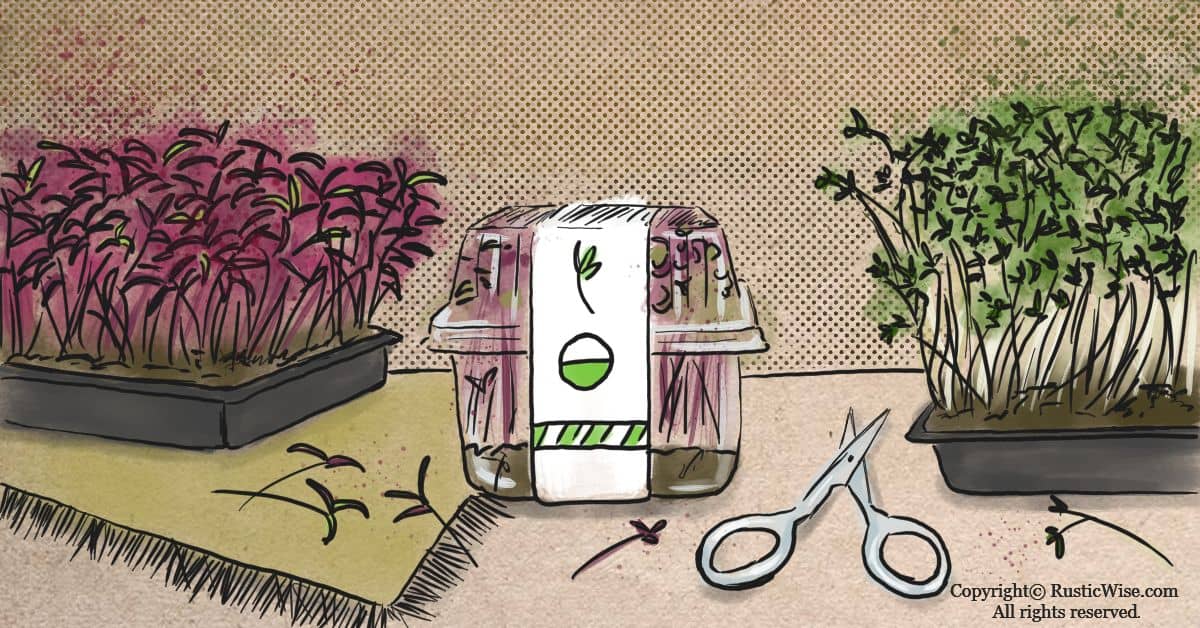Where To Sell Microgreens: 5 Best Places
Microgreens are a fast-growing and exciting food trend that have been making a splash in both the culinary and health food industries. Many people are starting profitable microgreens businesses from home. They’re easy to grow, don’t take up much space, and provide an amazing variety of flavors and textures. But where to sell microgreens if you’re just starting? The answer is as varied as the types of microgreens themselves! We’ll cover where to sell microgreens: farmers’ markets, restaurants, grocery stores, direct to customers, and caterers.
Starting a microgreens business is exciting, but there are so many options that it can be hard to know where to start. There’s no one right way to get your product into people’s hands. You may start with a few different markets at first, and only stick with the ones that work best for you.
In this article we’ll cover five different ways for new growers like yourself to get your product into people’s mouths…and hopefully turn some heads along the way!
Do your research first
The first step in launching any successful business is to do your research first. This includes looking at a few basic factors:
- Competitors: Chances are, you’re not the only local business trying to sell microgreens. Check out what the competition is offering: what types of microgreens they’re selling, their price points, their packaging, and where they sell their product. Watch what other microgreen growers are doing online: who has an established website, or a Facebook page, etc.
- Local market demands: Is there a demand for healthy food items in your area? What types of cuisines are popular? Are there a number of restaurants and cafés that specialize in farm-fresh options, gourmet, or offer healthy or vegetarian options? This give you an idea of the local demands of businesses and end-customers in your area.
- Competitive edge: What sets you apart from the competition? Perhaps you might choose to offer microgreens that no one else is selling. Or perhaps you can offer live microgreens when others are only selling pre-harvested greens. Find an area that you feel you can excel in.
Before you get too far, don’t forget these 2 things
One important aspect of becoming a successful grower is marketing and presenting your product in an attractive, professional way. Before you start approaching potential businesses and customers, remember to pay attention to: 1) Packaging; and 2) Labelling.
Microgreens packaging
There’s no perfect solution to packaging as almost all packaging leads to some sort of waste. However, it’s important to protect the fragile stems and leaves of microgreens from damage.
The most common form of packaging is the clamshell, which protects delicate ingredients from breaking and provides a close-fitting lid to keep out dirt and debris. Most clamshells are not biodegradable, but they are recyclable in some areas with municipal recycling centers. A good size to start with is 2 ounces (especially for grocery stores or farmers’ markets). While some restaurants may like smaller clamshells, others may prefer larger sizes between 4–8 ounces.
Labelling
The face of your product is on your label. Each package of microgreens should have labelling with the following details:
- Business name and logo
- The date harvested
- Name of microgreen
- Website (if applicable) or contact information such as an email or phone number
Tip: Bring free samples wherever you choose to market your microgreens. Everyone loves samples! Not only is this a good way to showcase your fresh greens, it’s also a great way for you to gain feedback on what people like.

Where to sell microgreens: 5 best places
Here are five different markets you can sell your tiny greens (listed in no particular order).
1) Selling microgreens to restaurants
One of the first markets people think to sell microgreens to are local restaurants or cafés. Not all types of restaurants are interested in using microgreens. Focus your efforts in finding restaurants with an emphasis on farm-fresh produce, eating locally and seasonally, or those that offer gourmet dishes.
The key is understanding the restaurant’s needs and making sure you know how your greens will fit into their menu.
Make a list
So where exactly do you find a list of potential restaurants and cafés? A good place to start is online.
Here are a few places to start looking:
- Yelp
- Delivery services like SkipTheDishes, Uber, DoorDash which often list many local restaurants
Familiarize yourself with the menu
Check out the restaurant’s menu before you go become familiar what kind of cuisine they offer. This way you can target the right microgreens to each business.
For example, many Asian and Indian cuisines have dishes that go well with daikon radish, or pea shoots. Italian restaurants may like basil, cilantro, or cress. Others may like a splash of color from red cabbage or amaranth microgreens.
Plan your visit
Practice your sales pitch before you go.
Ask to speak to the head chef rather than the manager as he/she is the one you’ll need to impress. You can either try to call to set up an appointment, or try to reach them on Facebook via private message. Most restaurants have a Facebook page where you can send them a message, and they will get back to you.
The last thing any restaurant wants is an unexpected sales pitch during their dinner rush.
Chefs are busy people. Ensure you pick a good time when they’re free of distractions and not rushing to prepare for the next meal.
Some restaurants are closed Monday. They often place orders for fresh produce on Mondays and Tuesdays; and again on Wednesdays or Thursdays. Many restaurants get deliveries in the morning (between 7–10 a.m.) and/or in the afternoon (between 2–4 p.m.).
While every chef has different preferences, many seem to like microgreens packaged in clamshells between 4–8 ounces.
After your meeting with the chef, don’t forget to follow up! You may not hear back, so you’ll need to follow up several days later in-person, or via email or Facebook message.
Understand that what most chefs are looking for are consistency in the microgreens, high-quality produce, and reliable shipping times. If you’re lucky to land a few steady customers, restaurant sales can be a reliable form of income. You may only need a handful of customers to stay afloat.
Tips: Make a list of restaurants in your area that seem like potential markets. Call ahead to try to set up an appointment. Remember to bring plenty of samples. Ask ahead if there are any specific variety of microgreens they’d like to sample.
2) Selling microgreens at farmers’ markets
One of the easiest ways to get your foot in the door is to set up a table or stand at a local farmers’ market. Farmers’ markets are a great way to get your microgreens in front of an intimate audience and connect with consumers on a personal level.
Before applying for a stand at a farmer’s market, do a bit of research first to see the types of vendors currently selling there. If there already are microgreens vendors there, you may decide to try another farmers’ market first.
Some chefs shop at farmers’ markets, so this is a great way for you to possibly meet them face-to-face. By making yourself a regular presence at farmers’ markets, you’ll benefit from word-of-mouth from happy customers.
This is the perfect place to bring tons of samples. Many people aren’t familiar with these tiny greens—displaying a fresh tray of microgreens is a great way to start conversations with passers-by. You’ll need to invest in a few large coolers to store your microgreens.
Tips: Remember to bring plenty of business cards or print-outs with your business information. Consider printing out “fact sheets” or different recipe ideas on how to use microgreens.

3) Selling microgreens to grocery stores
Many local grocery stores are selling specialty produce these days including sprouts and microgreens. While some larger grocery chains may be open to buying microgreens from small, local suppliers such as yourself, many already have contracts with larger distributors.
Instead, focus your efforts on small, independent grocery stores, or those that focus on organic or health foods.
One benefit to selling to grocery stores is you’ll be able to sell in bulk. You may need to reduce your price per unit, but it works out in the end if you’re selling more volume.
When you have your microgreens sitting in front of an audience it’s free marketing!
A downside to selling to grocery stores is you’ll want to keep an eye out for the freshness of your greens on a regular basis and replace any (at no cost) that look wilted.
4) Selling microgreens directly to consumers (delivery)
With the onset of the pandemic, many people are staying in and eating at home more often. People are also looking for easy ways to incorporate healthy greens into their diets. What better way to reach consumers than to sell directly to them with a subscription-based service?
You’ll need to set up a website where people can sign up for your service and where you can accept payment (PayPal or credit card). You’ll also need to decide on whether you’re planning to make the deliveries yourself, or if you’ll need to hire drivers.
It makes sense at first to focus your subscription service in one area first so you’re not driving all over the place. As your business grows, you’ll be able to expand your offerings to more areas.
Consider the frequency of delivery you’re willing to offer: weekly, bi-weekly, or monthly.
Setting up a subscription service for microgreens ensures you have a direct connection to your end-consumer. You can ask them for feedback and suggestions for new microgreens they’d like to try.
5) Selling microgreens to caterers
Many catering businesses are looking for new trends to keep their clients happy, and microgreens may be just the thing!
Caterers often do large events such as weddings or corporate functions. You may be able to supply microgreens for several large events. A busy time for caterers is around major holidays (think Christmas and Easter), and during wedding season (usually spring and summer).
With caterers, you may receive sporadic orders for a large quantity of microgreens. While this may suit some people, you’ll likely need to supplement the business you get from this market with other markets too such as restaurants or farmers’ markets.
Tips for marketing your microgreens business
This post can’t cover all the business aspects of marketing, but a good place to start for all microgreens businesses is to set up a business Facebook page. Most people are on Facebook. This gives customers and potential customers a platform to see what you’re offering and contact you with questions.
Once you get more serious, or as you build your customer base, you’ll want to consider setting up your own website too.
To reach new customers, consider setting up Facebook ads or Google ads and target them to your audience.
If you need help creating professional-looking graphics, consider a free program such as Canva where you can design and use templates to create great-looking ads and images. They even have free business card templates!
For more information about what types of microgreens to grow, check out our post, A Guide To Finding the Most Profitable Microgreens.
Related questions
How much time do you need to spend on a microgreens business?
The amount of time you choose to spend really depends on what you want to get out of it. Many people start their own little microgreens farm as a side hustle and expand gradually.
Over at The Penny Hoarder, they interviewed one entrepreneurial woman who worked roughly 25 hours a week and brought home $1,100 a month in profit selling microgreens. Of course this is only one example. The amount you make each month really depends on a number of factors. But how much time you spend is really up to your end-goals, and of course how much time you’re willing to dedicate.
Do you need a license to sell microgreens?
This really depends on where you live. Some jurisdictions require permits while others don’t if you’re only selling as a side business. Please do your due diligence and look into any applicable licenses and permits you need to obtain before going all-in.
👉 If you like this post, see our Complete Guide to Growing Microgreens at Home. 🌱
Would you like more timeless tips via email?
Fun tips to help you live an independent, self-sustaining lifestyle. Opt-out at any time.


References:
- Colby, Sally (13 December 2018). “Growing Microgreens for Chefs,” https://cfgrower.com/growing-microgreens-for-chefs/ Country Folks Grower. Accessed April 2021.
- CoreysCave (26 September 2018), “How to Sell Microgreens,” https://www.youtube.com/watch?v=9nwdyjEuYMY. Accessed April 2021.
- Shain, Susan (27 August 2018). “How You Could Easily Make an Extra $400/Month Selling Tiny Vegetables,” The Penny Hoarder. Accessed April 2021.

Author: Josh Tesolin
Josh is co-founder of RusticWise. When he’s not tinkering in the garden, or fixing something around the house, you can find him working on a vast array of random side projects.









